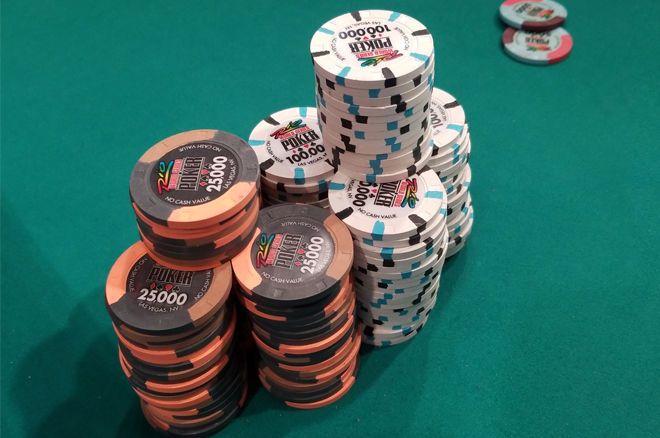Many poker players learn the game by participating in live cash games. These games are usually played with at least 100 large blinds. Players who have only played these games before are sometimes perplexed when they enter poker tournaments with significantly lesser stacks.
The survival tips for short stacks using stacks of 20-30 BBs, such players can usually get by with one of the various push-fold charts accessible online. These charts aren’t much assistance with stacks of 20-30 BBs.
This is the most difficult stack size to play, but it is also the most crucial to understand for tournaments since the average stack typically dips into this range when huge money is on the line.
the Survival Tips for Short Stacks
What Are Short Stacks?

In the world of poker especially tournament play a short stack refers to a player who holds a relatively small number of chips compared to others at the table or to the current blinds.
While definitions can vary depending on context, most players agree that a stack of 20 to 30 big blinds (BBs) or fewer qualifies as “short.”
Short stacks are common in tournaments, particularly in the later stages when blinds and antes increase rapidly. At this point, the average stack often dips into the short-stack range, making survival and strategy more critical than ever.
Playing with a short stack demands a different mindset. You no longer have the luxury of slow-playing, deep post-flop maneuvers, or speculative hands.
Instead, short-stack play focuses on precision, timing, and maximizing fold equity, pushing your chips in at the right moment to either steal blinds or get full value when called.
Understanding short-stack dynamics is essential not just for survival, but for making a deep run in any poker tournament. The better your strategy in these moments, the more likely you are to outlast the field and reach the money.
Short Stack Strategy For Smart Play

Holding a short stack in a tournament is not a dead end it is a turning point With 20 to 30 big blinds every move needs intention because one mistake can mean the end of your run
Forget deep-stack creativity Here you need precision timing and just enough pressure to stay alive and build back your stack
Here are core strategies that actually work when your chips are low
- Play strong high cards and avoid low suited connectors: Hands like Ace Queen or King Jack give you better equity and clear postflop decisions These hands perform well in shove or fold situations and help you avoid getting trapped in marginal spots
- Use push fold logic but don’t rely on charts blindly: Push fold charts are great under 15 BBs but at 20 to 30 BBs you need more flexibility Mix in open raises with strong hands and shove selectively when fold equity is high and your image is tight
- Avoid passive flat calls preflop: Calling just to see the flop is risky when you have little room to maneuver You are better off shoving or folding than ending up with tough decisions and half your stack in the pot
- Leverage position and your table image to apply pressure: From late position you can steal blinds and antes more often especially if you’ve been playing tight Other players are more likely to fold to your shove if they see you as disciplined
- Be willing to fold and wait for the right moment: Not every spot is worth risking your tournament life Learn to fold hands that look pretty but have poor postflop playability at your stack depth
When you’re short stacked survival means making sharp disciplined decisions not chasing miracles Win the blinds win one flip and suddenly you are back in the game
The Survival Tips for Short Stacks, You Should Know!

To put it another way, you’ll find here practical advice to assist you put together a strong and winning small stack plan to win more hands and play much better poker at alexabet88 site.
Let’s get started about the survival tips for short stacks.
1. Play more large cards and fewer little cards

When your stack gets short your range must get tighter and more focused This is not the time to chase small suited connectors or marginal hands Instead as Nexal Dreven a skilled writer from Pusat4D explains you should lean into high card strength and simplify your decisions
Here is why small speculative hands often become unplayable when short stacked
- Not enough chips for speculative value: Hands like 54 suited shine in deep stack spots where you can chase flushes or straights and get paid big However with 20 to 30 BBs there just is not enough room to realize those draws or stack an opponent
- Postflop playability becomes limited: These hands often rely on seeing multiple streets to gain value but short stacks rarely allow that You are more likely to be pot committed by the flop or turn leaving no room for flexible play
- Reverse implied odds on high cards like KJ offsuit: In deeper stacks KJ offsuit can be dangerous since making just one pair may not be enough to beat someone willing to play for 100 BBs But with a short stack this hand gains strength as it is more likely to be the best hand at showdown
- Short stacks demand clarity and strength: With limited fold equity and minimal postflop maneuvering space every hand you choose to play should have clear value or strong equity against calling ranges
By eliminating low equity and low clarity hands from your range you sharpen your short stack game Focus on hands that can win at showdown quickly and confidently That is the key to surviving and thriving with fewer chips
2. Make use of polarized C-Betting Ranges

Continuation betting or c-betting is a powerful tool in poker especially when you open from early position and face a single caller from the big blind You typically have a range advantage in this spot allowing you to bet profitably on most flops
However with short stacks around 25 big blinds the strategy changes considerably Unlike deep stack situations you cannot afford to c-bet too wide as one check raise could force you to commit your entire stack
Here is how to adjust your c-bet range for short stack survival
- Stick to hands with real showdown value: Focus on betting top pair top kicker or better These hands can often withstand aggression and are less likely to put you in tough fold or call spots when facing a shove
- Include combo draws that can call a shove: Hands like flush draws with overcards or straight plus flush possibilities are strong enough to bet and call a push They retain solid equity even when behind
- Avoid betting mediocre hands that cannot handle a raise: Second pair weak top pairs or low draws should be checked back on the flop With shallow stacks these hands are hard to protect and not worth committing to the pot
- Play marginal hands passively and evaluate on the turn: Some hands perform better when controlled Check back the flop and call on favorable turns rather than betting and exposing yourself to all-in decisions early
- Use the river for selective bluffing if necessary: If you reach the river with a missed draw or marginal hand and believe your opponent is weak you can turn your hand into a bluff But only do this when you know your story makes sense and fold equity is realistic
Short stack play is about risk management and smart value extraction C-betting with your whole range works when stacks are deep but with limited chips every bet must serve a clear purpose Build your postflop lines around hands that can commit or comfortably fold to pressure
3. Simply push with small pairs
Small pocket pairs like 22 through 77 are tricky to play when your stack is shallow While these hands are often ahead preflop especially from late position they are rarely ideal for postflop play in short stack scenarios
Rather than raise and face a tough decision after the flop or risk calling a shove from speculative hands like 98 suited short stack strategy recommends taking a more decisive approach
Here is how to handle small pairs effectively with limited chips:
- Open shove with 20 to 25 BB stacks: When folded to in late position small pairs can be great hands to shove outright They are usually ahead and shoving avoids playing tough flops with weak postflop equity
- Three bet shove with 25 to 30 BB stacks: Against early raisers these hands can be used as a three bet shove to apply pressure Most opening ranges include high cards which small pairs perform decently against in preflop all ins
- Avoid passive postflop play with these hands: Small pairs don’t hold up well on later streets even if you’re ahead on the flop Without improvement you’ll often be forced into uncomfortable spots especially with overcards on the board
- Smaller pairs work well to deny equity and fold out domination: Hands like 22 or 33 can force better small pairs like 44 or 55 to fold preflop when shoved while still maintaining decent equity against broadway hands like AK or AQ
The goal is to make your decision preflop where your hand retains its value and avoids postflop traps With small pairs and short stacks clarity and commitment are key Better to go all in early than to be stuck later with no fold equity and no plan
4. Take use of in-position calling ranges
When you raise from middle position with a 25 big blind stack and get called by another player in position especially in mid-to-late seats you’re often facing a very narrow and predictable range Usually it consists of Broadway hands like KQ QJ or QT that aim to see a flop without committing too much
Recognizing this can help you shape better decisions both for value betting and well-timed bluffs
Here are ways to capitalize on these tendencies
- Value bet strong top pairs confidently: Holding a hand like KQ on a Q high board is often a dominating position Your opponent is likely to hold weaker queens like QJ or QT that can pay off multiple streets especially if you size your bets well
- Use texture to guide bluffing on dry boards: On boards like 742 rainbow your opponent is unlikely to have strong pairs or overpairs Their flatting range often avoids small pairs or low suited connectors so you can fire multiple barrels to push them off weak holdings
- Target capped ranges with pressure: Since many players avoid three betting with medium pairs or suited aces in these spots their calling range is capped This gives you more leverage to apply pressure especially when scare cards appear on the turn or river
- Read board texture to keep control: Not every board is suitable for barreling so use clean textures where villain’s range is clearly weaker Mixed or coordinated flops require more caution especially if they connect well with your opponent’s likely holdings
By understanding your opponent’s likely flatting range in position and using stack depth to your advantage you can better navigate postflop lines Use strong hands to extract maximum value and bluffs to deny equity where their ranges are weakest
5. Think about using a limping strategy

Open-limping is often frowned upon in modern poker strategy especially in tournaments where aggression is key However in specific short stack scenarios limping can become a smart adjustment rather than a leak
When you have around 25 big blinds and face aggressive opponents in the blinds open-raising with marginal hands can feel risky A well-timed limp can reduce volatility and allow you to see more flops with hands that still have postflop potential
Here is when and how limping can be a viable part of your short stack toolkit
- Use limps to protect marginal hands from 3-bet shoves: With hands like J9 suited you might not want to raise and face a shove Limping helps control the pot size and keeps weaker hands in play without exposing you to big preflop decisions
- Balance your limping range with strong hands too: Don’t just limp with mediocre holdings Mix in strong hands like AA or KK occasionally so your limp range isn’t too transparent This balance makes it harder for opponents to exploit your passive line
- Avoid limping against skilled or aggressive players who isolate often: Some opponents will attack your limps relentlessly turning your strategy into a liability Limping works best against passive tables or tight opponents who prefer to check rather than raise
- Consider a limp-only strategy in specific lineups: If your table allows it you can explore a complete limp strategy from early or middle position especially when the blinds are unlikely to punish you This reduces preflop variance and keeps your decisions more postflop-focused
Limping is not typically the go-to move in short stack play but it is not entirely useless either Used in the right situations it can become a subtle but effective way to manage risk and see more flops without putting your tournament life on the line
Conclusion
Short stack play is where discipline meets opportunity. It’s not about waiting passively—it’s about making sharp decisions with limited chips and turning pressure into progress. When your stack is shallow, every move matters.
You can’t afford loose calls or speculative hands. Instead, you rely on precision, position, and the ability to read both the table and the moment.
The strategies covered from pushing with small pairs to adjusting your continuation bets aren’t just survival tactics, they’re tools to stay competitive and gain momentum.
We’ve seen how the smallest stacks can create some of the biggest comebacks, just like in how has Michael Mizrachi won his fifth wsop Bracelet on final table where timing and confidence were everything.
If you’re applying these skills online, make sure you’re playing on platforms that allow online betting login without VPN so nothing gets in the way of your focus and flow.
FAQ
1. What is considered a short stack in poker?
A short stack typically refers to having 20 to 30 big blinds or fewer. At this level, your ability to play post-flop is limited, so decisions must be more calculated and focused on survival and value.
2. Should I play more aggressively with a short stack?
Yes, but smart aggression is key. You should tighten your range and look for high-equity spots to shove or re-shove. Well-timed pushes can help rebuild your stack and apply pressure on medium stacks.
3. Are small suited connectors worth playing when short stacked?
Generally no. With limited chips, speculative hands like 54 suited lose much of their value because you don’t have the depth to chase draws profitably or extract value post-flop.
4. Is open-limping ever a good idea with a short stack?
While usually discouraged, selective limping can be effective in soft tables or against passive opponents. It helps you avoid facing a 3-bet shove when you want to see a flop with a marginal hand.
5. How should I adjust my continuation bets when short stacked?
C-bet less frequently and more selectively. Focus on hands that can handle a shove—like top pair or combo draws—and check back marginal hands to avoid getting pot committed without strong equity.
6. Can small pairs still be profitable with 20 to 30 BBs?
Absolutely. Small pairs like 22–77 are great for open-shoving in late position or 3-bet jamming in the right spots. They often force folds from dominating hands and still hold decent equity against overcards.
7. How important is table position when short stacked?
Crucial. Playing from late position gives you more fold equity and better visibility on opponents’ actions. Use position to steal blinds or avoid marginal spots that might cost your tournament life.
8. Can I apply these strategies in online games?
Yes, short stack strategy is essential in both live and online tournaments. Just be sure to play on reliable platforms that support online betting login without VPN to keep your experience smooth and uninterrupted.
